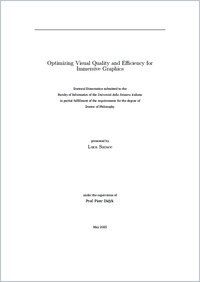Optimizing visual quality and efficiency for immersive graphics
- Surace, Luca
- Didyk, Piotr (Degree supervisor)
- 2025
PhD: Università della Svizzera italiana
English
Advancements in graphics algorithms and display technologies are enabling more immersive and realistic virtual experiences, such as telepresence and digital replicas of the real world. However, achieving high visual fidelity comes with significant computational and power costs, which can sometimes hamper the adoption of the technology. In some situations, the quality of displayed content may exceed the limits of human vision, leading to a suboptimal use of computational resources. This highlights the need to optimize the trade-off between quality and efficiency in graphics applications. In this dissertation, I propose methods that leverage the limitations of the Human Visual System (HVS) to optimize this trade-off. Foveated rendering reduces computation by sampling fewer image pixels in peripheral vision while preserving high-quality near the gaze location. From this sparse image information, Generative Adversarial Networks (GANs) can reconstruct high quality images by hallucinating missing content based on learned image statistics. However, the choice of training loss and procedure critically impacts reconstruction quality. Therefore, I first present a strategy to make the GAN training less sensitive to distortions that humans cannot detect while emphasizing perceptually important artifacts, enabling the reconstruction of visually significant image features. The strategy is evaluated using a newly trained objective metric and user experiments, demonstrating significant improvements in perceived image quality. Additionally, the results show higher sensitivity to distortions in images containing structures, such as edges and boundaries. This insight led us to develop another technique for handling geometry, specifically addressing distortions in mesh silhouettes, as they exhibit noticeable luminance discontinuities. The method computes the optimal Level Of Detail (LOD) of peripheral meshes to improve performance by reducing the polygon count. It analyzes the geometrical differences between meshes, including interior and silhouette, and handles temporal changes between LODs, making it suitable for real-time applications. Besides computational efficiency, other factors affect power consumption of devices. In virtual reality headsets, the display is the main energy consumer, making power saving critical for battery-powered systems. To address this, I propose a method that leverages visual adaptation in immersive environments to optimize power efficiency by adjusting display brightness based on the content. By analyzing the luminance frame through pyramid decomposition, the algorithm finds the optimal brightness that preserves spatial contrast (e.g. details) while maintaining a specific power budget. This offline technique is suitable for video streaming and animated movies, while an online version based on a reactive algorithm works for interactive applications, still maintaining stable contrast loss. Although software-based, our method directly influences hardware power consumption, as confirmed by measurements on custom hardware. All three techniques follow a common methodology: collecting perceptual data, modeling visual mechanisms, and validating through subjective experiments.
- Collections
- Language
-
- English
- Classification
- Computer science and technology
- License
-
License undefined
- Open access status
- green
- Identifiers
-
- NDP-USI 2025INF012
- ARK ark:/12658/srd1332901
- URN urn:nbn:ch:rero-006-123308
- Persistent URL
- https://n2t.net/ark:/12658/srd1332901
Statistics
Document views: 79
File downloads:
- 2025INF012: 33
